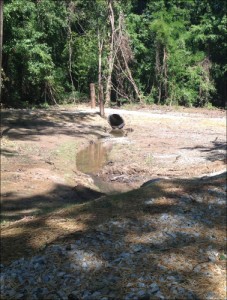Hurricane Joaquin highlighted the effect that upstream water retention has on downstream currents and flooding. It makes us more aware of being upstream neighbors of coastal areas like the Cape Fear region and also our immediate neighbors downstream.
The water that Joaquin dumped on our roofs and flowed down our gutters and downspouts and across our yards into tributaries of Northeast Creek will eventually join water that fell on roofs in Guilford County and flowed down the Haw River. Then it will collect the water that has fallen more recently on roofs in Sanford and Fayetteville before it reaches that bridge. The large area of the Cape Fear River drainage basin includes a lot of neighborhoods, with water flowing from upstream neighbors to downstream neighbors, affecting the use of water and the condition of the stream boundaries along the way.
Closer in, the water from Northeast Creek flows into Jordan Lake, which is the water supply for a number of neighborhoods as well as the towns of Cary and Morrisville. The Town of Cary in turn will supply additional water to the City of Durham during drought conditions.
More local, the water that runs off all at once from roofs, sidewalks, driveways, and streets (surfaces designed not to allow the water to soak in, called “impervious surfaces”) can erode downstream neighbors’ yards. The collecting of rapid runoff at creek junctions can back up into yards and threaten to flood under houses.
As homeowners, we can extend the principle of catching and holding rainwater to restrain how much water and how fast its flows downstream during a rainstorm. These actions can affect the amount of erosion of stream banks in downstream neighbors’ yards and reduce flooding of downstream neighbors’ property. We can also save back some of that water for dry spells, hold it long enough to recharge the water table here instead running rapidly the length of the Cape Fear River, and create more habitat for pollinators.
A reasonable goal is to capture the first inch of rainfall from the square feet that your property has as impervious surfaces and hold it for up to three days. There are a variety of ways to do this; the county Soil and Water Conservation District (in Chatham, Durham, and Wake counties for Northeast Creek) can provide technical assistance and tips for beginning your plan of rain saving. And you need not hit the goal of “one-inch saving for at least three days” all at once; you can try different combinations of techniques on your property to see what works best.
Cory Quammen, a resident of Grandale Forest on the headwaters of “Tributary D” of Northeast Creek, is holding a gathering of his upstream and downstream neighbors, Saturday, October 24, 9am – 11am to show some examples of problems caused by excessive runoff as well as some rain-saving measures that have been installed on his property.. Invitations will go to the neighbors within his local creek basin in advance of the meeting. Contact cquammen@gmail.com for further information.

